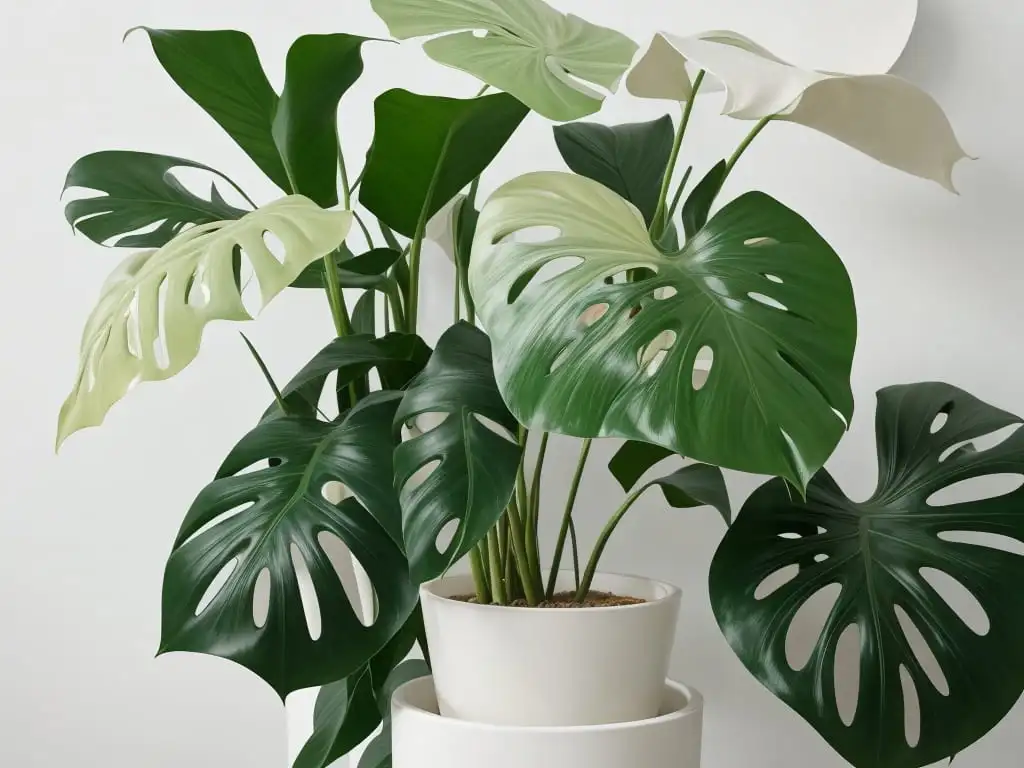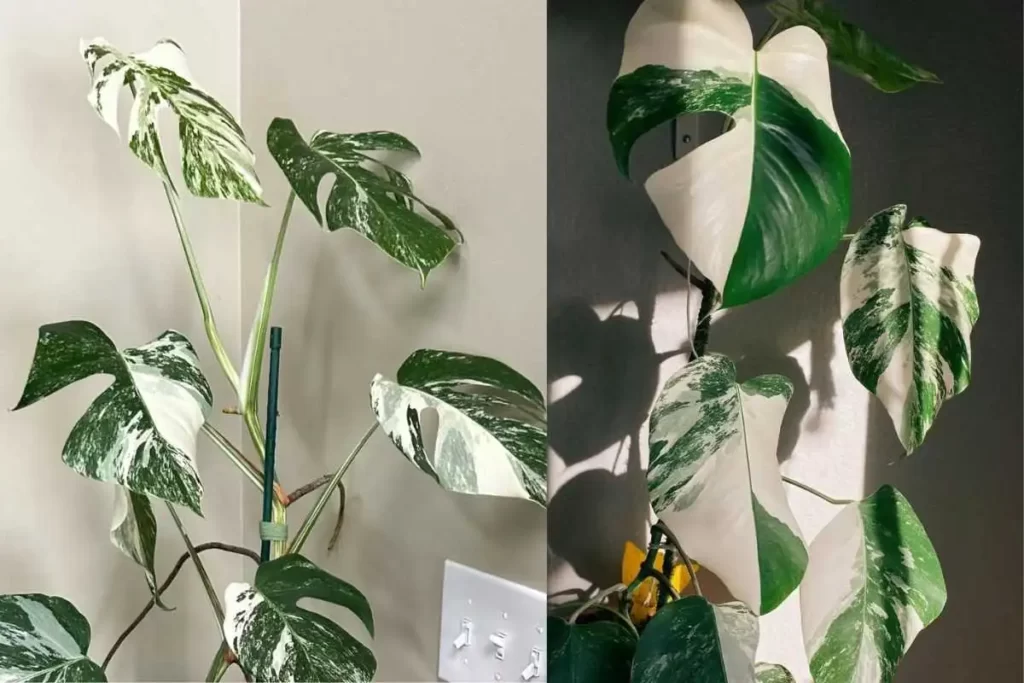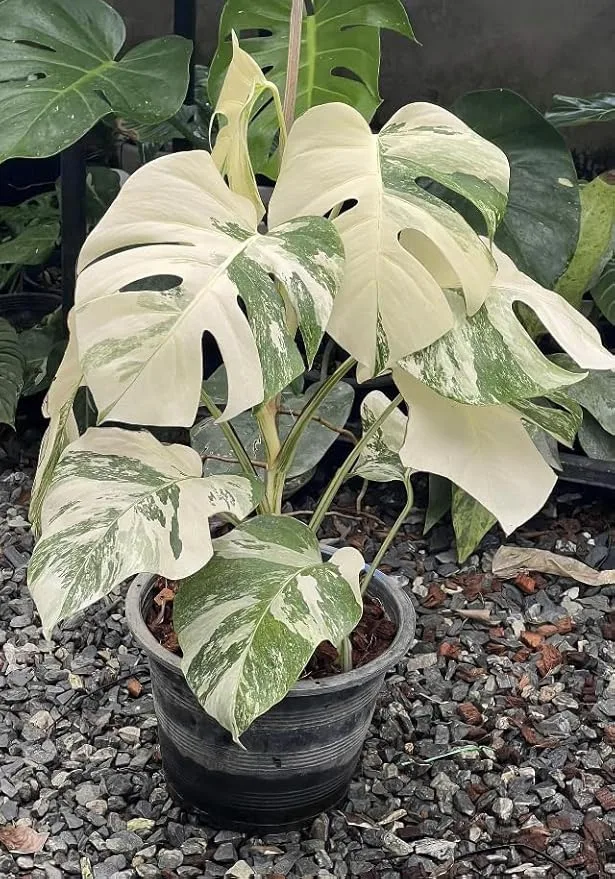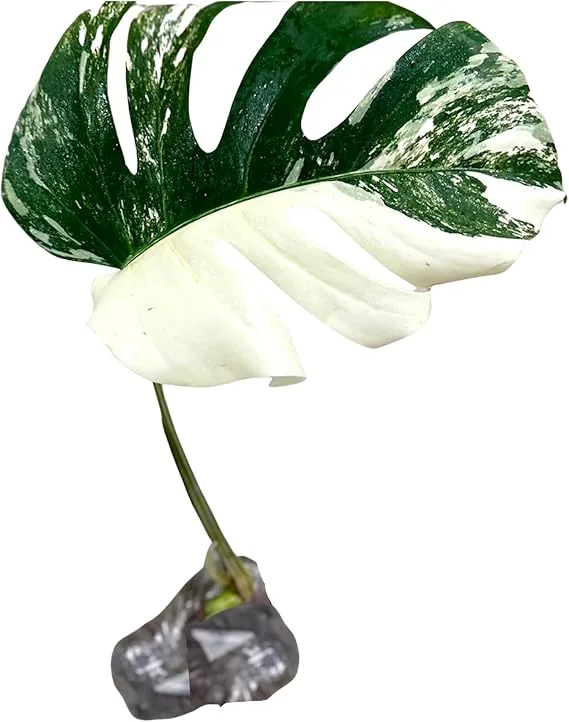In the world of houseplants, few specimens command as much attention and fascination as the albino Monstera.
With its striking white foliage and air of enigmatic rarity, it has captured the hearts of plant enthusiasts worldwide.
In this complete guide, we will delve into the intriguing world of albino Monstera, exploring its origins, characteristics, care requirements, and propagation methods.

Unveiling the Albino Monstera
What is an Albino Monstera?
The Albino Monstera, scientifically known as Monstera deliciosa ‘Albo Variegata,’ is a unique cultivar of the popular Monstera deliciosa.
What sets it apart is its stunning variegation, characterized by large sections of pure white or cream-colored foliage.
This variegation is a result of a genetic mutation that affects the chlorophyll production in the plant.
A Brief History
The exact origins of the albino Monstera are shrouded in mystery, but it is believed to have first appeared in the 1930s.
Since then, it has gained a cult following among plant collectors and enthusiasts, fetching high prices due to its rarity.
Read: Types of Monstera: Top Beautiful Swiss Cheese Plants.
Characteristics of Albino Monstera

Foliage
The most striking feature of the albino Monstera is its unique foliage. Unlike the standard Monstera deliciosa, which boasts lush, dark green leaves, the albino variety exhibits large, white or cream-colored sections.
These patches lack chlorophyll, rendering them unable to carry out photosynthesis.
Growth Habit
Much like its non-variegated counterpart, the albino Monstera is a climbing plant that can reach impressive heights when provided with the right conditions.
Its aerial roots allow it to attach itself to a support structure, making it an ideal candidate for vertical gardens or hanging baskets.
Size
Under optimal conditions, an albino Monstera can grow to be several feet tall. The size largely depends on factors such as light, temperature, and available nutrients.
Also Read: Monstera Aurea & Pinnatipartita: Care, Propagation, Troubleshooting, & All.
Buy Best Monstera Albo:
1. Monstera Albo Variegated Plant 4 Leaf Full Plant Rooted with High Variegation

2. Monstera Albo Plant Live 18-24 Inches

Albino Monstera Care Requirements
Let’s delve deeper into the specific care requirements for an albino Monstera.
Light
As mentioned earlier, providing the right amount of light is crucial for the health and well-being of your albino Monstera.
While it thrives in bright, indirect light, it’s important to note that direct sunlight can be too harsh and may result in leaf burn.
Consider placing your plant in a location with dappled sunlight or use a sheer curtain to filter the light. If natural light is insufficient, supplement with artificial grow lights designed for indoor plants.
Temperature and Humidity
Maintaining a consistent temperature range of 65-75°F (18-24°C) is optimal for an albino Monstera. It’s important to shield the plant from extreme temperature fluctuations, as it can be sensitive to sudden drops in temperature.
In terms of humidity, providing a moderately high humidity environment is beneficial. This can be achieved by using a humidifier, placing a tray of water near the plant, or misting the leaves regularly.
Additionally, consider situating the plant in a naturally humid area of your home, such as the bathroom or kitchen.
Soil and Potting
Choosing the right soil and pot for your albino Monstera is essential. Opt for a well-draining potting mix enriched with organic matter.
This combination provides the necessary aeration for the roots while retaining moisture. Ensure the pot has drainage holes to prevent waterlogging, which can lead to root rot—a common issue with Monstera plants.
Watering
Proper watering practices are crucial for the health of your albino Monstera. Allow the top inch of the soil to dry out before watering, as this helps prevent overwatering.
When you do water, ensure that excess water can drain freely from the bottom of the pot. This prevents water from accumulating in the soil, which can lead to root issues.
Fertilization
During the growing season (spring and summer), your albino Monstera will benefit from regular fertilization. Use a balanced, water-soluble fertilizer every 4-6 weeks to provide the plant with essential nutrients.
However, it’s important to adjust the frequency and strength of fertilization based on the specific needs of your plant, as individual conditions may vary.
Read: Monstera Plant Care: A Complete Guide for Beginners.
Monitoring Growth
Due to the variegation, albino Monsteras may exhibit slower growth compared to standard Monstera deliciosa.
This is because the white portions of the leaves contain less chlorophyll, which is essential for photosynthesis.
However, it is important to note that the white portions of variegated leaves still contain chlorophyll, and variegated plants can still photosynthesize, albeit at a slower rate.
The slower growth rate of variegated plants is more likely due to the fact that they have less photosynthetic tissue.
In other words, the white parts of the leaves cannot photosynthesize as efficiently as the green parts. As a result, variegated plants have to work harder to produce the same amount of energy as all-green plants. This extra effort can slow down their growth rate.
However, it is important to note that the growth rate of variegated plants can vary depending on a number of factors, such as the amount of light they receive, the temperature and humidity of their environment, and the nutrients in the soil.
Some variegated plants may grow just as fast as all-green plants, while others may grow significantly slower.
Overall, the care requirements for an albino Monstera are the same as those for a standard Monstera deliciosa.
However, it is important to keep in mind that albino Monsteras may grow slower due to their variegation.
By providing them with the proper care and attention, you can help your albino Monstera thrive and produce beautiful, variegated foliage.
Propagation Techniques
Let’s explore the propagation techniques for albino Monstera in greater detail.
Water Propagation
Water propagation is a popular and straightforward method for propagating albino Monstera. Here are step-by-step instructions for water propagation:
- Select a Healthy Stem: Choose a healthy stem with at least one node. Nodes are small bumps on the stem where leaves, roots, and branches grow from.
- Prepare a Jar or Vase: Fill a clear jar or vase with water. Ensure that the node of the cutting is submerged in the water, while the rest of the stem is above the waterline.
- Place in Indirect Light: Position the jar in a location with indirect sunlight. Avoid placing it in direct sunlight, as this can cause stress to the cutting.
- Monitor Root Growth: Roots should begin to develop within a few weeks. Keep an eye on the water level, and if it becomes murky, replace it with fresh water.
- Potting in Soil: Once the roots have reached a substantial length (about 2-3 inches), carefully transplant the cutting into a pot with well-draining soil. Ensure that the node is buried beneath the soil’s surface.
Soil Propagation
Soil propagation is another effective method for propagating albino Monstera. Here’s how to do it:
- Choose a Healthy Cutting: Select a healthy stem with at least one node. This node is crucial for root development.
- Prepare a Pot and Soil: Fill a pot with well-draining potting mix enriched with organic matter. Ensure the pot has drainage holes to prevent waterlogging.
- Plant the Cutting: Bury the cutting in the soil, ensuring that the node is beneath the soil’s surface. Gently press the soil around the cutting to provide stability.
- Provide Adequate Moisture: Keep the soil consistently moist but not waterlogged. Check the soil regularly and water when the top inch feels dry.
- Monitor Root Growth: Roots should begin to develop over the coming weeks. You can gently tug on the cutting to check for resistance, which indicates root growth.
- Transplant if Necessary: Once the cutting has established a healthy root system, it can be transplanted into a larger pot if desired.
Air Layering
Air layering is a more advanced propagation technique, but it can yield excellent results. Here’s how to air layer an albino Monstera:
- Select a Healthy Stem: Identify a healthy stem on the parent plant. This will be the stem you’ll be air layering.
- Make an Incision: Create a small incision in the stem, about one-third of the way through the stem’s diameter. This is where roots will develop.
- Apply Rooting Hormone (Optional): To encourage root growth, you can apply a rooting hormone to the incision.
- Wrap in Moist Substrate: Surround the incision with a moist substrate, such as sphagnum moss or a mix of perlite and peat moss. Cover this with plastic wrap to hold it in place.
- Secure and Wait: Secure the plastic wrap in place with string or plant ties. Keep the substrate consistently moist.
- Monitor Root Growth: Roots should begin to develop within a few weeks. Once they are well-established, carefully remove the rooted section and pot it in well-draining soil.
These detailed propagation techniques offer various options for multiplying your albino Monstera and expanding your plant collection.
Remember to be patient and provide the necessary care and attention during the propagation process.
Read: How to Propagate Monstera: A Step-by-Step Guide.
My Additional Tips about Propagating:
- When water propagating, use distilled or filtered water to avoid any impurities that could harm your cutting.
- When soil propagating, make sure to use a well-draining potting mix to prevent root rot.
- When air layering, be sure to keep the substrate moist but not soggy.
- Be patient and allow the roots to develop fully before transplanting into a new pot.
With proper care and attention, you should be able to propagate your albino Monstera successfully using any of these methods.
Challenges of Cultivating Albino Monstera
Here are some of the challenges that come with cultivating an albino Monstera in more detail:
Slow Growth
One of the primary challenges with albino Monstera is its relatively slow growth rate compared to its non-variegated counterparts.
This is due to the variegation, where the white sections lack chlorophyll, a crucial pigment for photosynthesis.
As a result, the plant may have a reduced capacity to produce energy, which can lead to slower overall growth.
It’s important for caretakers to be patient and not expect the rapid growth often associated with standard Monstera deliciosa.
Vulnerability to Sunburn
The absence of chlorophyll in the white sections of the leaves makes them more susceptible to sunburn. While all Monstera varieties appreciate bright, indirect light, it’s especially crucial for albino Monstera.
Direct sunlight, even for a short period, can lead to irreversible damage to the leaves. It’s recommended to provide filtered or dappled sunlight, or use sheer curtains to diffuse intense light.
Specialized Care
Albino Monstera may require a bit more attention and care compared to standard Monstera deliciosa. Given its variegation, it’s essential to closely monitor its light exposure, humidity levels, and watering schedule.
Finding the right balance can be a delicate task, and caretakers should be prepared to adjust their care routine based on the specific needs of the plant.
Prone to Pests and Diseases
Albino Monstera, like other houseplants, can be susceptible to common pests such as spider mites, mealybugs, and aphids.
Additionally, it may be prone to diseases like root rot if overwatered or if there isn’t adequate drainage. Regular inspection of the plant for signs of pests or diseases is crucial for early intervention and treatment.
Limited Availability and High Cost
Due to its rarity and high demand, acquiring an albino Monstera can be a challenge in itself. They are often sought after by collectors, which can drive up prices.
Additionally, finding a reputable source for purchasing an albino Monstera may require some research and patience.
Variegation Stability
Maintaining the variegation in albino Monstera can be a concern for some caretakers. Variegated plants may produce leaves with varying degrees of white, and sometimes revert to completely green leaves.
This can be due to genetic factors or environmental stress. Ensuring consistent care and providing the right conditions can help maintain the striking variegation.
Navigating these challenges requires a careful and attentive approach to caring for an albino Monstera. By understanding and addressing these potential issues, caretakers can create the best possible environment for their unique and stunning plant.
Remember, every plant is a living entity with its own individual needs, and attentive care will lead to a thriving albino Monstera.
Related FAQs:
What Causes the Variegation in Albino Monstera?
The variegation in albino Monstera is the result of a genetic mutation that affects the production of chlorophyll, the green pigment responsible for photosynthesis.
In the albino variety, certain sections of the leaves lack chlorophyll, giving them a distinctive white or cream color.
Can Albino Monstera Survive with Limited Sunlight?
While albino Monstera can tolerate lower light conditions, it still requires a certain amount of indirect sunlight to thrive.
It’s best to provide bright, indirect light to ensure the plant receives enough energy for growth. Avoid placing it in areas with very low light levels.
How Can I Maintain the Variegation in my Albino Monstera?
A3: Maintaining the variegation in albino Monstera can be a bit challenging. Providing consistent, bright, indirect light is crucial.
Avoid exposing the plant to prolonged direct sunlight, as this can lead to leaf burn. Additionally, ensure you’re following the recommended care guidelines to support overall plant health.
Is It Possible to Propagate Albino Monstera from Variegated Cuttings?
Yes, it is possible to propagate albino Monstera from variegated cuttings. Follow the propagation techniques outlined in the guide, making sure to select a healthy stem with at least one node.
Keep in mind that variegation may vary among propagated plants, and not all cuttings may exhibit the same level of variegation as the parent plant.
Why Is My Albino Monstera Growing Slower Than Other Plants?
The slower growth of albino Monstera is attributed to the variegation. The white sections lack chlorophyll, which is essential for photosynthesis.
As a result, the plant may have a reduced capacity to produce energy, leading to a slower overall growth rate compared to non-variegated plants.
Can I Convert My Green Monstera into an Albino Variety?
Converting a green Monstera into an albino variety is not possible, as variegation is a genetic trait. The albino Monstera’s unique characteristics are a result of a specific mutation.
While you can propagate albino Monstera from variegated cuttings, the parent plant will remain green.
Are There Any Special Pruning Techniques for Albino Monstera?
Pruning albino Monstera follows similar principles as standard Monstera deliciosa. Regularly removing damaged or yellow leaves and trimming excess growth can help maintain the plant’s health and appearance.
However, be mindful not to remove too much foliage, as the plant’s variegated sections are less efficient in photosynthesis.
How Can I Increase Humidity for My Albino Monstera?
Increasing humidity for your albino Monstera can be achieved by using a humidifier, placing a tray filled with water and pebbles near the plant, or misting the leaves regularly.
Additionally, situating the plant in naturally humid areas of your home, such as the bathroom or kitchen, can provide a boost in humidity levels.
Can I Grow Albino Monstera Outdoors?
While albino Monstera can be grown outdoors in some climates, it is generally recommended to keep them as indoor plants.
They are more sensitive to temperature and light fluctuations, making them better suited for controlled indoor environments.
Why Are Some Leaves on My Albino Monstera Turning Green?
It’s not uncommon for albino Monstera to produce leaves with varying degrees of variegation. Some leaves may have more green, while others may be mostly white.
This can be influenced by factors such as light exposure and genetics.
How Often Should I Repot My Albino Monstera?
Repotting is typically recommended every 1-2 years, or when the plant has outgrown its current container. When repotting, choose a pot that is 1-2 inches larger in diameter than the current one.
Be sure to use a well-draining potting mix and handle the roots gently to avoid damage.
What Should I Do if My Albino Monstera Gets Pests?
If you notice pests on your albino Monstera, it’s important to take action promptly. Use insecticidal soap or neem oil to treat the affected areas, following the manufacturer’s instructions.
Quarantine the plant to prevent the pests from spreading to other plants.
Can I Use Artificial Light for My Albino Monstera?
Yes, you can use artificial grow lights to supplement or replace natural light for your albino Monstera.
Choose a full-spectrum grow light designed for indoor plants and adjust the duration and intensity based on the specific needs of your plant.
Why are the Tips of My Albino Monstera’s Leaves Turning Brown?
Brown tips on the leaves of your albino Monstera may be a sign of low humidity or over-fertilization. Increase humidity levels by misting the leaves or using a humidifier.
Avoid over-fertilizing and ensure you’re following the recommended fertilization schedule.
Can I Propagate Albino Monstera in Water Permanently?
While water propagation is a great way to encourage root growth in cuttings, it’s not recommended to keep albino Monstera in water permanently.
Once roots have developed, transplant the cutting into well-draining soil for long-term growth.
Are There Any Varieties of Albino Monstera Other Than ‘Albo Variegata’?
‘Albo Variegata’ is the most well-known and widely recognized albino Monstera variety. However, there may be other rare mutations or cultivars with similar characteristics that have emerged over time.
These may have different names or designations within the plant enthusiast community.
Also Read: Is Monstera Toxic to Cats & Dogs?
Conclusion
The albino Monstera is a living work of art, captivating plant enthusiasts with its ethereal beauty. While it may present some challenges in cultivation, the rewards of successfully nurturing this rare gem are immeasurable.
With the right care and attention, your albino Monstera can become a stunning centerpiece in your plant collection, evoking awe and admiration from all who encounter it.
So, embark on this botanical journey, and let the mystique of the albino Monstera enrich your green space. Happy planting!

